Space Stations

Since the beginnings of spatial colonization, the problem has arisen of life (or survival) in an environment intrinsically hostile to man. Since the early ages of the conquest of the seabed during the nineteenth and twentieth centuries, man wondered about the best way to experience life in an inhospitable environment, whether deep ocean floor Where the pressure and the cold are considerable, to the canyons of Mercurian craters where the pressure is lacking as well as a temperature with the bite of the sun exceeding 200 ° C ... All the experimental approach was to lead to the end of the XXth century Life in a space station, closed by nature, as much as a submarine can be. Recycling air, water, maintaining pressure, hydrometry and acceptable temperature are vital necessities. But we must not neglect the psychological factor, the promiscuity of a human group deprived of all mental and natural "breathing", which are at the origin of many concepts that have marked and still mark the conquest of space.
To make the counterpart to the idea of installing a base, a sort of terrestrial version of an orbital station on an extrasolar planet, the idea germa to conceive an artificially autonomous closed environment in a "security" environment, Earthly occurrence. This was the series of the "Biosphere", followed, after disadvantages precisely related to the artificiality of its position, of another unique experience, based on the deliberate deception of a crew destined for Mars, thanks to the means of the technology. Six months of travel, this was the duration of the mission. And the ship never got into Martian orbital injection. And for good reason: He was enthroned, filled with cheap cables and hydraulic systems, in a vast black painted hangar in the heart of Canada.

This experience will be particularly rewarding if it has not been renewed. From this point onwards, the composition of the crews of distant missions is more concretely considered. By 2020, the goal is, more clearly than ever, Mars. We are working to create an infrastructure that has never been seen since the Apollo missions. The Alpha station, ISS, was composed of modules of various origin, which presented problems of compatibility. From 2010 onwards, we define what a "standard" module should be, in terms of dimensions, weight, minimum equipment, type and diameter of airlocks, etc. This first step is decisive: From At that time, all the space nations, joined by China and India, modified their launchers to orbit these new modules. These will be produced in series more uniform and more important than ever. They will also find themselves on the first ships destined Martian. This also applies to scuba and survival equipment. The Russians bring their know-how in all these fields.
When terraforming begins, the installed bases have in turn gained the status of "city". Each processor is indeed generated by a community of at least 500 settlers.
Let\'s jump back in time: Here we are in 2130. A first Jovian orbital station, more than two years of traveling the earth. Not the slightest help to be expected before that date. And what goes for Jupiter is also worth for its satellites. Also, the combined experience of the ISS and the first Martian base will be extremely valuable. Such a base, whether orbital or terrestrial, must be autonomous for at least two years. This leads to resizing of the infrastructure, which are all migraines for the engineers responsible for thinking about it. Two years.

Maps on the table, if human holds, how can the material survive? No submarine remains two consecutive years at sea: The equipment needs a revision, the crew will release the mental pressure. So many are seriously thinking about the all-automated. Reason gives them the backing of the rulers: Is not it the cheapest solution, in every sense of the word? ... Then it will be Joveye, arrived on the spot in 2123. But this one will demonstrate the possibility To install orbital stations in the inner layer of the Jovian atmosphere, where, at a certain depth, but in the midst of colossal cloud masses saturated with electrons and cleanly cataclysmic winds, a pressure of one atmosphere , Making any pressurization unnecessary, a temperature varying between -60 and 30 ° C., and ... a lot of oxygen. If you do not dream, these conditions can not be found on your daughters. In order to supply the methane ogre in tanks and new stations, Io, Europe, Ganymede and Callisto, to mention only the most important, are likely to become mining and steel bases of prime importance. One can not envisage bases on their surface for more than two years, as absolute autarky. And this time the presence of man is no longer desired. It is indispensable. The first colonial bases were born, the most important in truth, because their function was to enable the establishment of other bases and to facilitate the development of colonies of more than 5,000 individuals. There are three levels of colony type, and this typology varies little since:
The first "base" is not one, it is the telluric probe that comes to rest on the surface and explores it through robots. Then, since nothing replaces the human eye, the first colonial settlement takes the form of a small research structure based around 6 to 8 settlers. A small team of specialists who do not require anything but three main modules and a greenhouse. The greenhouse for fresh food, for the capture of supernumerary CO2 and for oxygen, the other modules for energy, recycling and controls, parts to live. A small workshop complete the set, as well as a pressurized vehicle and a small two-seater open rover. All this requires only a few parachutes (in the case of a reduced atmosphere), where some braking with gas. Nothing insurmountable. Such a base was designed to provide autonomy greater than one and a half years, remained the psychological factor. It became imperative to extend the vital space of the colonial teams. The best remedy for depression and neurasthenia was to immerse yourself fully in the work, with motivation for the first arrivals, to build one\'s own places of life, to improve one\'s own comfort. This benefited the self, but also the community as a whole, and therefore the following teams. These concerns were those of settlers of the second basic type, that of 50 colonists and more. In principle, the basic structure was based on the first type, with a question of scale. For 50 settlers, about fifteen modules had to be set up, connected to each other, connected so that one could go from one to the other without worry.

It is the concept of economy of scale that has been used to bring down the price of design and manufacture of so-called "standard" modules. Here is the description of one of these "cisterns" as they were nicknamed very quickly in the jargon of the spationauts:
"It must allow six astronauts to work in weightlessness without interfering, and to do this, measures four meters in circumference for twelve in length. In reality, the internal part is only perceived over a thickness of three meters. The remaining part is a double partition which acts as a safety hull (depressurization is the number one enemy), and a partitioned compartment for water tanks, recyclers, a small stock of freeze-dried A module is designed to house five astronauts for one month in perfect autonomy ... Above all, each cylindrical module must have two male locks / Female adaptable in all situations, allowing a great flexibility in the assembly of macrosystems These lock boxes, permanent apertures in principle when the modules are connected, Are fifty centimeters in diameter, so that a medium-sized person can easily slip into it and have side doors that can block access to it if depressurization is detected. Gare to the one who is in the passage at this moment because this closure is instantaneous. These systems have their importance in space, but in a station based on land, with real gravity, they present more disadvantages than advantages. "But the old system was maintained for the simple reason that it was more economical than to develop specific structures, as the settlers have been told to do with local resources, More rudimentary, but also more spacious and therefore more comfortable.
The third type of base concerns an already more ambitious scale, since it must allow the establishment "for life" of more than 2,000 settlers. This requires serious infrastructures that can only be built up after the realization of the structural work by the teams of the second type of base. Indeed, from these figures, we now speak of "station". If one summarizes the activity of the teams of the first establishment, destined to the search of the best sites of mining extraction, that of the second category deserves our attention:
In this case, one no longer speaks of "exploration" base but of "extraction" basis. If this word does not cover all realities, it summarizes the main activity of any base of about 50 colonists: To allow the development of an industry leading to the construction of larger reception structures. A team consists of fifty settlers, sent according to their original situation, in pairs or singles. What matters individually is competence. By rarely sending families on the spot, for the simple reason of the very confined conditions of life of the place, harmful to the good development of a child. In addition, the settlers have more free time but also a greater availability. This latter factor should not be neglected when the competence of a single one allows the survival of the whole group. Short stays (less than a year) by rotating teams are in any case a common reality for all these bases.
Among these settlers, there is the existence of trades adapted to a position, a module in particular, but the skills are interchangeable. Of course, each settler is specialized in a particular field, but he must be interested in other disciplines on board, not even in his spare time. This allows, in case of a blow, to have enough medical personnel. It is moreover in this field that the most often accepted cross-skills on the part of the settlers. All are given general training, presenting the different aspects of life in these special environments and the minimum knowledge required to operate the systems whose survival depends. Perfect interchangeability does not exist, but complementarity and potential help always. A community in such a hostile environment is systematically tight.
There is no direction strictly speaking in a database, but there is at least one member of the community who is in charge of managing the teams, through communication systems and real-time vision this character is a coordinator . It must ensure that relief arrives very quickly from the best place and, more generally, from its responsibility in a large number of decisions concerning the implementation of systems, the replacement of a person, The regulation of the different, the general policies of exploitation, the vigilance to the performance, the arbitrations ... It plays the role of a captain. However, this heavy burden par excellence must be imperatively shared. Also, for all important decisions, settlers meet in one of the common modules. For the decisions in the "restricted college", which must be taken quickly, the permanent communication of the settlers both in the base and outside is of an obvious practicality. This manager must be assisted by two persons, who respectively play the roles of jurist, external communicator, and psychologist of the colony, intercessor. There is a control module within the bases of this type, generally located at the top of the structure and which, if necessary, has large picture windows. But to avoid any risk of decompression, the vast majority of the modules have no opening on the outside if not their airlock. All the "windows" that give the colonists the impression of seeing the exterior do not exist as such: They are screens connected to external cameras.
The control rooms use panoramic cameras which give an overview of the outer area, sometimes so complete that it covers almost the entire interior surface of the module, giving the impression of being in a vacuum. Management is thus tripartite. Practice proved it was a reliable system. For important decisions, there is no module large enough to accommodate the 50 settlers. Thus, the two who serve as a refectory are requisitioned. Decision-makers also enjoy the mealtime for political decision-making because stresses are reduced and allow to focus on the essentials in a relaxed atmosphere.
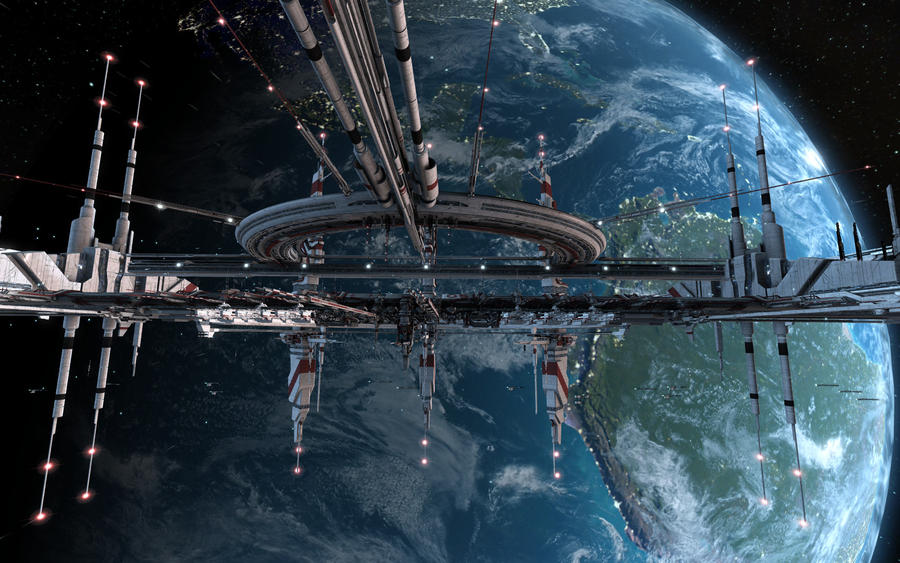
Other important positions include medical services, comprising three permanent members, one of whom has a strong psychological specialty. They operate in a single module, but have an operating unit in a bacteriological isolation cell, a scanner and two additional beds. Its capacities are reduced, depending on the place concerned, and its dangerousness, some bases could have two or even three modules dedicated to medical services. Three survival modules, three specialists, also have a vital role on each base:
The recycling unit is by far the most crucial system, since it depends on the pressure control of the entire base, by injecting, if necessary, the gas, its composition and its content of pathogenic elements, Hydrometry of the modules. It is a duplicate of the systems already existing in the double-shell of each module, but with higher oxygenation capacities. Each has carbon dioxide-fixing tanks, which are cooled, concentrated and reconverted into liquid, the latter serving to supply a melting cell, which supplies light and heat to the photosynthetic biounit of the edge. The latter, identical to the belt packs of the colonists\' outer combinations, consists of a light generating unit, which feeds bioreceptor microalgae with photosynthetic superproductivity, and recycled gases in the general breathing system such as nitrogen and argon.
The water treatment unit is also vital, since all contaminated liquids are recycled to it in a very old classic process. But this unit quickly loses value because in general "natural" water is received on the spot by separation of the elements, in large quantity on most of the colonized worlds. This, however, requires distillers, who because of their rusticity can be produced locally by the settlers. This module, for the rest of the time, collects all the sewage sludge and heats it, dehydrates it before storing it for the hydroponic units.

The energy unit is also essential. For all the needs of the base, each module should be energetically autonomous. However, when too large numbers of systems work together the energy deficit is filled by this module, connected the whole. The latter also allows the engines of most of the vehicles and machines used to be loaded. The technician who is in charge of it must therefore monitor the operation of a massive hydrogen-fueled cell, a reliable and proven solution. Another very important unit, in the long term, the two hydroponic modules. The latter have the dual task of producing oxygen and feeding the crew with fresh plant products. Only one specialist takes care of this work, which is relatively calm, but which requires the utmost attention. Above-ground biological balance is a science that can not be improvised. It also has at its disposal the means to create new plant species and best manages the population of insects that ensure a cyclic load in the biological balance of the environment. This specialist is not responsible for feeding the board: This load is rotating and entrusted to settlers who have a module for storage and cooking. The latter is usually located in the immediate vicinity of the refectories.
The established balance gives the competence of 10 colonists, and the necessary existence of 18 modules *, knowing that one or two constitute the medical antenna, one for the control room, another for the energy unit, A kitchen, two refectories, a sports hall and a common room, and five common rest rooms (provided for ten settlers), two cabin modules (for couples), one Cistern of pure water (deoxygenated), and two agropod halls. The forty other settlers are in fact devolved to the functioning of the community and punctually under the orders of the various aforementioned personages. For example, when installing wiring and piping between modules, about 20 settlers work together under the direction of the recycling, communications and energy specialist. This tightly knit community will, when it is first on the scene, have to build the first workshops for a heavy steel industry. The first priority is to melt materials and to produce very simple structures for the purpose of designing hangars and large awnings (generally more than one hundred and twenty meters long by thirty wide and ten high). The first will be used to house the machine tools producing parts for the large foundry. These machine tools are usually disembarked by the ship at the same time as the crew and the containers that house them are designed to be demountable and to constitute a hangar serving as a warehouse and workshop at the same time (six containers constituting a shed enough Extensive, but not pressurized.). The second of these hangars, pressurized, will house the settlers in much better conditions. The motivation of the crew to achieve this is therefore very special.
The large foundry is of fundamental importance: not only will it be possible to produce one-piece steel strips of more than 30 meters in length, making up the flexible roof of the hangar, but also massive partition walls, Lockers, whole modules, vehicle parts ... Autonomy for everything that is rudimentary. However, the design of more complex structures requiring more elaborate machine tools, these must be produced using a matrix that reconverts the by-products of the foundry. This matrix, too delicate to be produced, is also deposited in a container at the beginning of colonization. With the original foundry and the matrix, the colonists can produce everything necessary for their long-term survival. But of course the supply of these depends on the extraction carried out by the teams in charge of prospecting in minerals. The latter have a fleet of five vehicles, two of which are massive, with four-member survival units, two simple quick-link vehicles, and a bulldozer.
On the model of these hangars, a third can be started, with enough room to accommodate a large fish pond, and superimposed land for agropod crops, and poultry in battery. The latter will therefore greatly improve the diet: So far the colonists have to settle for rare citrus fruits and rehydrated lyophilized dishes. The construction of each of these large hangars is of biblical simplicity: A large rectangular excavation, sinking at a depth of three meters, is built on the base plan of the hangar. The latter will be elaborated by placing the large steel laths above the excavation, each bearing on the slope. Each large batten is therefore curved and placed thanks to a crane, built thanks to the foundry.
When all the slats are assembled, they are meticulously welded and barred by lateral reinforcements. Then the two facades are built, the welded joints, and the only exits become lock chambers. Then all the internal part of the hangar is carefully vitrified at very high temperature until it has the consistency of the granite and is waterproofed thanks to a thin net of nanometric organic fibers obtained by recycling and braided into a tight mesh. The latter allows only the smallest molecules to pass. This "tarpaulin" is then covered in turn by a sieve of earth or concrete, depending on the destination of the building. All that remains is to equip it as the modules of an energy unit and a unit for recycling air or other equipment, and to pressurize it.

A team could, during the one year of its planetary stay, carry out all its objectives and succeed in setting up four or five hangars before the second team arrives. So the next one simply increased the capacity of the colony, and found new extraction sites. In this way, a base could pass in about ten years from fifty to more than one thousand two hundred colonists. On some planets, conditions were sufficiently mild to favor the construction of a translucent shelter, a swollen greenhouse (by pressurization), with a much larger area for crops.
Wonders of technology produced in series, the Modules are the elementary bricks of the stations, ships and bases: It is the fundamental unit of habitation in hostile environment. Their origin dates back to the ancient times of spatial colonization, when it was the size of larger launchers that determined the maximum permissible dimensions of one of these units. Each nation had its own model, and there was little compatibility before the beginning of the 21st century. It will be necessary to wait for the extension of the ISS and the construction of the first vessels to march to conceive a standard respected by all. The creation of the International Space Agency, the SIA, was a major step towards the standardization and industrial production of equipment destined for space, by competition from private companies, which had to offer the most guarantees. The budgets were lightened and helped to boost the 2020-2050 projects. But it was not until 2045 that the type of module usable could be defined. Again, the new generation of Asian, Indian, Pakistani, Malaysian, Australian, Korean, Chinese, and Indonesian launchers was used to set a maximum size and weight. Standardization will thus reveal a model that will last until 2250, date of new advances and discoveries of the first importance which will revolutionize these:
Modules 2045 were 9 meters long by 3 in circumference. They incorporated a double hull to counteract harmful and micrometeorite radiation. They were provided with a lock at each end, but without decompression chamber, place obligatory. They had a system of recycling air and clean water but depended on solar panels for the energy of the edge. In the event of an accident separating one of these modules from the others, rapid decompression ensued. Quickly, shutters were arranged in blades on each side of the airlock. In the event of a sign of pressure drop, in two tenths of seconds, the latter was firmly sealed. Beware of the one that is at this moment in passing from one module to another !. As a result of this modification, a clean energy system was incorporated, as an accident proved that a module with only batteries could no longer heat, the passenger compartment was deprived of light and soon with oxygen. The time that a rescue mission was set up was death for its occupants in less than a week.
Soon many initiatives were taken to improve safety, including the possibility of longer survival on board. The new 2250 standard merely endorses all the technological changes that contributed to maximum security of the modules, but with one drawback: Space conquest is carried out by industrial consortia under the patronage of the SIA but free to order options Of security they desire, outside mandatory minimums. Some crews are better off than others, but in general they do not have the leisure to know. In the case of a module equipped with all the survival refinements such as, at the other end of the scale, comfort, there is firstly a cell with cold fusion of hydrogen.
The latter has a lifespan exceeding three years. It supplies all the energy needs of the module. The latter has seen dimensions swell, due in particular to its production in orbital yards, and new generation launchers. With 16 meters in length for four meters twenty in circumference, it offers a better habitability. Its double-hull was carried this time to one meter, leaving a real habitable space of three meters twenty.
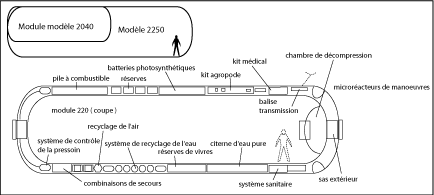 This double partition contains the fusion cell and its reserves, a communicating beacon system, a detection system, small maneuvering supply reactors, freeze-dried food stores for one month, and five astronauts without rationing, a kit Of agropod culture (allowing seeds and bins to quickly produce biological species producing fruits and citrus fruits), the constant temperature, pressure and humidity control system, the liquid recycler and the recycler Of air, a cistern of one hundred liters of pure water, the double partition consists of Mindium laminates, which is known to provide good protection against impacts by its molecular architecture, such as contaminations and radiations coming from the outside, At a certain point.
This double partition contains the fusion cell and its reserves, a communicating beacon system, a detection system, small maneuvering supply reactors, freeze-dried food stores for one month, and five astronauts without rationing, a kit Of agropod culture (allowing seeds and bins to quickly produce biological species producing fruits and citrus fruits), the constant temperature, pressure and humidity control system, the liquid recycler and the recycler Of air, a cistern of one hundred liters of pure water, the double partition consists of Mindium laminates, which is known to provide good protection against impacts by its molecular architecture, such as contaminations and radiations coming from the outside, At a certain point.
These modules also have a fairly complete medical kit, allowing benign interventions, a sanitary system, and a cover for a very special but exceptionally crucial use, since it is applied to the internal part of the opening threshold Of the airlock, it constitutes a sort of antechamber of decompression of fortune for an exit in space. To make a repair outside the module, it was considered good to equip it with two rather rudimentary combinations, with a photosynthetic pack. In case of depressurization, it is possible to intervene either outside or in the double partition, whose internal panels are removable.
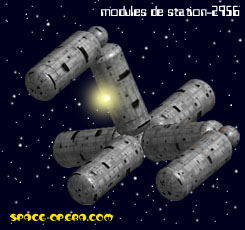 About Modules
About ModulesThese first "standard" modules formed the basis of any station or vessel construction at the beginning of the space conquest. They were 16 meters long, 4 inches wide, and were able to house almost six people in total autonomy. In practice, they were connected together easily thanks to standardized airlocks, thus constituting structures of considerable dimensions. It was easy to adapt all kinds of external systems, thrust blocks, solar panels, load-bearing structures, tanks, etc. They were easily adaptable as command posts, dormitories, food stores, laboratories, Sanitary blocks, etc. Below, a storage station, apparently without solar energy, due to the generalization of hydrogen batteries, durable and cheap. On their involvement in history, see "organization of bases", the dedicated chapter.
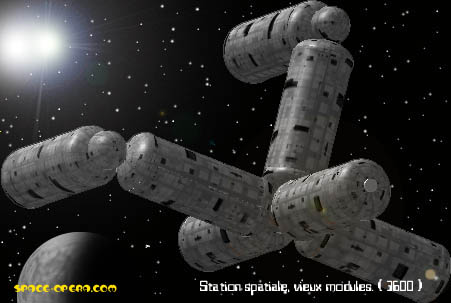 About Standard Space Stations 2200-2800
About Standard Space Stations 2200-2800These space stations, conceived as assemblages of standardized modules, have been extremely numerous and useful in the history of the beginnings of the conquest of space. Spread out in all Solsys, before being in other systems, they were at once bases and relays, warehouses, laboratories, factories, hospitals, workshops and arsenals, first fed by fragile solar panels at the mercy A rain of micrometeorites or any satellised debris - like the walls of the old stations of the XXIth century for that matter - then by hydrogen-fueled stacks.
A station could have up to 200 modules assembled thanks to their dome airlocks offering many combinations. Their flexibility made it possible to use them in all kinds of configurations, and their reduced cost, especially because they were built in space, saving a tedious orbiting from the ground, made them the assembling bricks Both stations and first vessels, until 2500, when the integration needs had evolved towards more efficiency.
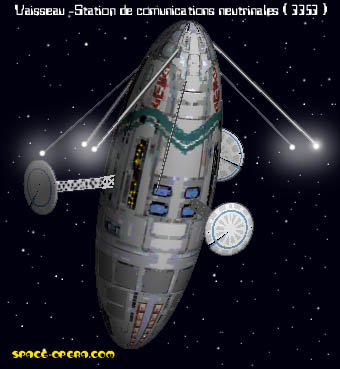 Schuzen Relays Stations
Schuzen Relays StationsThese stations, vessels specially designed to occupy a fixed position in the inter-space, are relays Chuzen (their second name). Their role is to generate passing signals that may be truncated, such as receiving them before returning. Their information being 55 times faster than the limiere, their role was found indispensable within the galaxy, especially between nearby stars (delay of transmission: soslys-proxima centauri: 0.07 AL or 52 days). The supposed isolation of settlers before that was therefore greatly diminished.
But it was necessary to work on even faster systems. With the development of giant accelerators, including that of the moon, we could demonstrate the existence of singular particles, the bansen, named after its discoverer, generated by the primordial vibrations resulting from the moment 0.000 00 0000 1 of the big bang. Still older than neutrinos but close in nature, these bansen could not be developed from simple AMAT accelerators. It was necessary to develop for them an entirely new engineering. This was only the case in 4620.
 Centauri
Centauri
 Grumiege
Grumiege
 Giesessen
Giesessen
 Rustofora
Rustofora
 Banastar
Banastar
 Paduca
Paduca
 Shenanda
Shenanda
 Sitansani
Sitansani
 Trecomsa
Trecomsa
 Eridani
Eridani